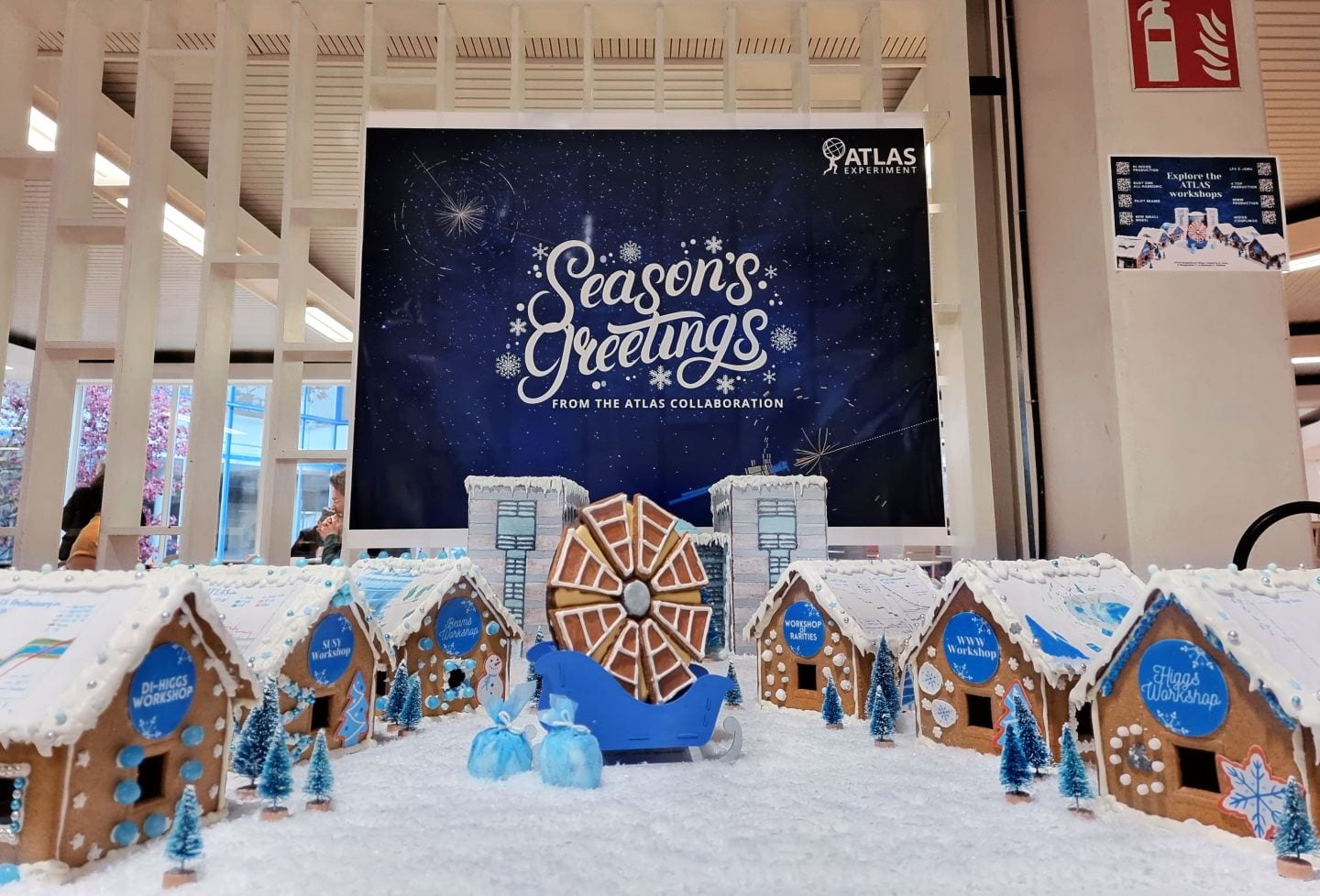
In this edition of the Friday Newsletter, we celebrate a graduation, gingerbread physics art, the promotion of one of our post-doctoral researchers, and a lot more!
Contents
CHAIR’S WEEKLY MESSAGE
“A Fall in Review”
I think it is safe to say we are all looking forward to saying “goodbye” to 2021. Nevertheless, there is a lot that I would like to highlight more positively as a way of noting how humans persevere in the face of adversity.
Several faculty who are funded through an “umbrella grant” from the U.S. Department of Energy’s Office of Science submitted a massive renewal proposal to enhance and extend their work through a new 3-year period beginning April 1, 2022. This grant proposal covers both particle and astrophysics subjects, from Higgs physics with the LHC, to observational astronomical surveys, to cosmology. We await the outcome of the review process on that proposal, but one notable thing was just how positive and upbeat all of the co-authors seemed at the time of submission. The work done in our department is fantastic, and you could really feel that energy from the proponents of this grant.
This wasn’t the only grant submitted by faculty in our department this fall, as many others were submitted to other funding agencies or external entities. We saw the submission of a massive multi-institution operations funding proposal for the SuperCDMS SNOLAB experiment, project funding for activities in our instrumentation laboratories for LHC and other programs, and a proposal for a Sam Taylor Fellowship. The seeds have been planted for a very exciting 2022.
I also extremely proud of the success of those faculty who submitted requests for, and earned, leaves from teaching in 2022-2023 so they can focus on their research programs. All requests were well-motivated: key project and research milestone periods arise next year for all of these faculty. Profs. Jodi Cooley, Robert Kehoe, Pavel Nadolsky, Fred Olness, and Jingbo Ye received well-earned and much-needed research leaves and in all cases but one will have a full semester of leave; in one case, the leave request was for a full year. This presents teaching challenges for the department, but we weathered a similar situation this year and we’ll do it again next year.
The Undergraduate Committee has been very active on reviewing the new introductory laboratory course curriculum and developing proposals for even more curricular updates for the coming years. We discuss some of that in this issue of the newsletter. In addition, the Graduate Committee has been hard at work in a difficult year, one where the graduate Core Proficiency Exams are being offered in two cycles (normally, we only do one cycle a year). This has required an “all hands on deck” approach from the Committee and the dedicated CPE Committee that constructs, executes, and grades the exams.
The Graduate Committee has also been hard at work on recruitment. The first big step was the earning of an inaugural Moody School for Graduate and Advanced Studies Ph.D. recruitment grant. We’ve spent about half of it already since getting it in October, all of the money going to support physical trips to places to actively recruit students in-person. Faculty and students made trips to the Texas Section of the American Physical Society meeting in Clear Lake, TX; Texas A&M University in Commerce; East Tennessee Status University; and Texas State University in San Marcos. These trips are investments, opportunities to meet new colleagues while also engaging with students. The goal of the grant was not to solve problems in just one year, but to plant the seeds of those solutions and provide a place to develop and build lasting and sustained relationships into the future.
Each visit has yielded at least one applicant to our program, an excellent rate of return already on this effort. The larger context is even more impressive: this year we have a record number of started, in-progress, and completed applications. Twenty-four applications are nearly complete or fully complete and ready for review (the priority consideration deadline passed on December 15, but we continue to accept applications to and beyond the nominal deadline of January 15, 2022). Last year was a strong year for our program in terms of number of applicants, and that saw a total of just over 20 completed applications by the end of the spring 2021 term. This year stands to be even more of a record for us, and this is particularly remarkable as most Ph.D. programs are recording declines in applications so far this year!
The Graduate Committee is the Ph.D. admissions committee in our Department. There is especially hard work to encourage the completion of applications. Review will begin review shortly to make early action offers as quickly as possible.
Students have also been major heroes this fall. The pressures on them have seemingly never been greater. After more than a year of remote education and social distancing, they were thrown back together into semi-normal gathering circumstances. The pressure to socialize was higher than ever (all of us felt that urge to socialize driving us). The workloads seemed more immense as well; many students reported that faculty across departments seemed to be assigning more work than ever as if this was needed to compensate for the remote-learning year. This was compounded with financial challenges posed by the current economy. We’ve seen rents go up, food prices climb, and many people are still recovering from the winter freeze disaster prompted by Texas’s insufficient electrical grid. Faculty sometimes seemed confused as to why students were so stressed. I am confused why the obvious is not obvious to credentialed academics.
My Physics Chair’s Student Advisory Council was, ironically, so busy and stressed that we never managed to meet even a single time. I hope to remedy that in the Spring, if things calm down … but here I am only cautiously optimistic.
Let’s try to put this semester behind us and, where possible, focus on the good. We made it. In some cases, it was a spectacular effort. As we go into the winter break, let’s hold onto the successes and rest to recover from everything else.
In this issue of the Friday Physics Department Newsletter, the last of the fall term, we celebrate a graduation, gingerbread physics art, the promotion of one of our post-doctoral researchers, and a lot more!
Sincerely,

Stephen Jacob Sekula Chair, Department of Physics |
DEPARTMENT VIEWS
Celebrating Graduations: Jing Xiaoxian, Physics Ph.D. and Machine Learning Researcher at Meta
 We celebrate our newest Ph.D. recipient, Dr. Jing Xiaoxian, on this, the eve of December Commencement. Jing earned his Ph.D. by pursuing theoretical and computational physics efforts centered on improving human understanding of nuclear structure, most especially the structure of the proton. His thesis, defended and submitted this fall, is entitled “Fast Statistical Methods for the Global QCD Analysis of the Proton Structure.”
We celebrate our newest Ph.D. recipient, Dr. Jing Xiaoxian, on this, the eve of December Commencement. Jing earned his Ph.D. by pursuing theoretical and computational physics efforts centered on improving human understanding of nuclear structure, most especially the structure of the proton. His thesis, defended and submitted this fall, is entitled “Fast Statistical Methods for the Global QCD Analysis of the Proton Structure.”
We asked Jing to tell us about his work after defending the Ph.D. and to provide some insights on how the Physics Ph.D. effort linked him to his current research. Here’s what reported.
Currently, I’m a Machine Learning Researcher at Meta, working on machine learning problems like ranking and classification of information. Right now, I’m still choosing which team to join. I’ve been working with several teams including Ads AutoML (which focus on improving model quality by figuring out which module to allocate more resources), FB integrity (build models to improve people’s experience while using the app by detecting harmful posts/ misinformation, etc) and News Feed ranking (focus on improving models that deliver the most relevant posts).
Last year, I accepted an internship at Facebook for three months, which led to the full-time job offer. During the three-month internship, my work was related to News Feed (the tab on the Facebook App) – Public Content Ranking. I accomplished two major projects: first, I reduced the model size while maintaining the model performance; second, I built a Successive Halving framework to perform efficient grid search and found a few model architectures that outperformed that in production.
I believe the physics background gives me a great advantage in this work. To my understanding, the physics research isn’t much different from the machine learning research: in both areas we are building models to understand how complex things work, with slightly different tools (physics requires rigorous math and explainability).
Dr. Jing Xiaoxian, SMU PhD `21
Congratulations to Dr. Xiaoxian on his success after earning his degree at SMU!
CERN Colloquium: Dr. Katharine Leney Presents the Latest Results in the Search for Two-Higgs Production Using the ATLAS Experiment
The Department Speaker Series is concluded for this calendar year, but the learning never stops. On November 23, SMU Research Assistant Professor and Co-Convener of the ATLAS Experiment’s Higgs and Diboson Searches Analysis Working Group, Dr. Katharine Leney, delivered the CERN LHC Seminar. This prestigious seminar series highlights big results from the LHC Experiments.

Dr. Leney summarized recent advances in the search for two-Higgs production, the process of making two Higgs particles simultaneously from a single LHC proton bunch crossing, and specifically from a single proton-proton interaction during that crossing. She also showed how both single- and double-Higgs production can tell us about the structure of the Higgs quantum field and the electroweak vacuum. Check out her talk!
New Elements of the Undergraduate Physics Curriculum Advance
The full-time faculty of the Department of Physics voted overwhelmingly in favor of proposed changes to the undergraduate physics curriculum. While far from final – such changes must next be reviewed and approved by the Undergraduate Council of Dedman College – these votes represent an important step forward for majors and minors in our program.
It has been long recognized by faculty, and increasingly by students, that key topics are simply absent from our foundational courses. For example, neither first- nor second-semester introductory physics instructs students in the basic concepts related to fluids, waves, or thermodynamics. Given the chosen pacing of our intro-level courses, it is simply impossible to accommodate these subjects. It’s already the case that our introductory courses move quickly, covering 1-2 chapters per week from a book like Halliday, Resnick, and Walker’s “Fundamentals of Physics.” Physics education research over the past few decades has concluded that slowing the pace of learning is a crucial ingredient in helping to build a more solid foundation for students, upon which one can build reinforcement and, much later, elements of mastery.
Speeding the pace of our introductory physics courses has not been seen as a serious option, so instead the Physics Department Undergraduate Committee developed a proposal to create a new sophomore-level course to teach these subjects at the introductory level. Faculty input from outside the committee was crucial in this effort and was gathered over months through electronic requests and discussion at monthly faculty meetings, as well as intermediate votes.
Students have also called for these same subjects to be taught at or near the introductory level. This was especially noted in reports from the Physics Chair’s Student Advisory Council that were collected and passed along to the Undergraduate Committee in 2020-2021. Students noted the severe gaps in material in our program. For example, undergraduates taking third-semester physics (PHYS 3305: Introduction to Modern Physics) are expected to know about a blackbody thermal spectrum, even though this is not covered at all in first-year courses.
The faculty have now overwhelmingly voted in favor of the creation of a new course, “PHYS 3304: Intermediate Physics: Waves, Thermodynamics, and Atoms.” It will be a mixed lecture and laboratory activity course, with two days of lecture and one day of lab. The course can be taken before, in parallel with, or after PHYS 3305. Currently, its only prerequisites are “PHYS 1106, PHYS 1304 or PHYS 1308, all at C-or above.”
In addition, the faculty voted overwhelmingly in favor of the following propositions:
- PHYS 3304 is an elective for the PHYS Minor.
- PHYS 3304 is required for the PHYS BA. The requirements for courses in Quantum and Classical Groups are reduced from “two courses from one group and one course from the other” to “one course from each group.”
- PHYS 3304 is required for the PHYS BS. PHYS 5383 is no longer required but offered as an elective.
- PHYS 3304 is required for the PHYS BS with Specialization in Cosmology and Astrophysics. MATH 3304 (linear algebra) is no longer required.
While these votes advance these proposals, the next step is formal submission of these revisions the Dedman College Undergraduate Council. The council will consider these proposals, ask for input from the Department, and typically then suggests revisions if they feel strongly about particular curricular issues. This process will still take months before a final decision is known, and it will be at least a year before these become official parts of the curriculum (e.g. in the SMU Course Catalog).
In addition to the above, the faculty also voted overwhelmingly in favor of the following proposals:
- SCI-4301 Astro-eXtraordinary: The Universe Beyond Earth, is added to the list of courses in other departments that may satisfy electives for a physics major.
- One out of the two electives for the PHYS BS may be chosen from the list of courses in other departments that may satisfy electives for a physics major.
Students who have questions about anything they read in this article should direct their inquiries to Prof. Simon Dalley, Director and Assistant Chair for Undergraduate Studies in Physics.
What’d I Miss?
We all get too many emails from the University and College. Here are the most important things you might have missed that affect our community.
- All Employees: The Department Main Office will be closed from December 23-31, 2021 in accordance the closure of the University during this period. No business will be conducted during this period. The main office will reopen on the first work day of the new year, January 3, 2022.
FACULTY NEWS
If you have something to share please feel free to send it along. Stories of your activities in research, the classroom, and beyond are very welcome!
STAFF NEWS
The department staff continue to work on behalf of Academic Operations (position currently vacant, but receiving ongoing support from Lacey Breaux) and Research Operations (Michele Hill). They can be contacted for assistance, or to make appointments for input and help, through the Department Main Office (FOSC 102).
Dr. Alessandra Betti to Start as Faculty at Sapienza Università di Roma
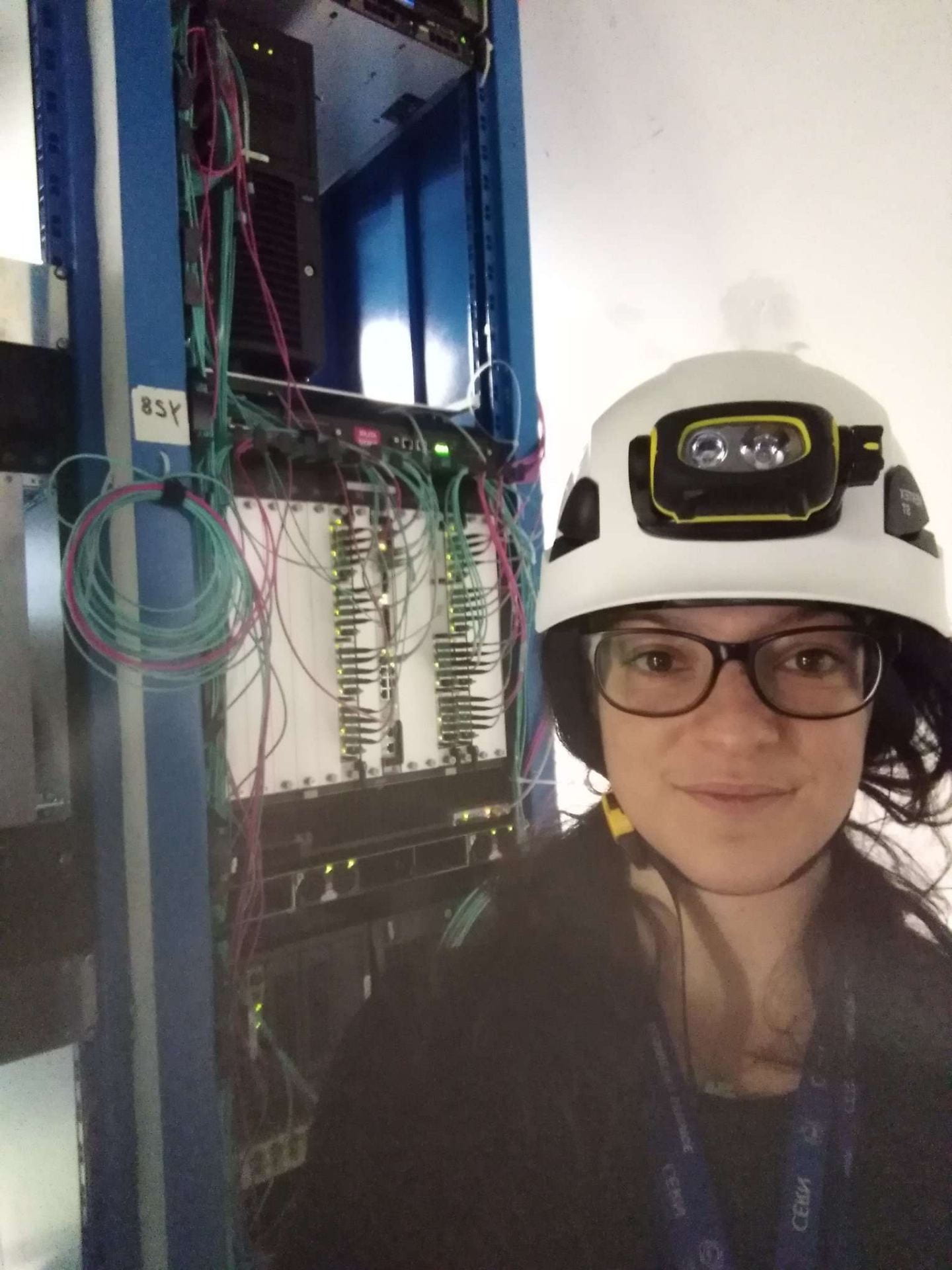 Dr. Alessandra Betti, a postdoctoral research fellow in the SMU ATLAS group, will move in the new year to the Physics Department of Sapienza Università di Roma to begin a research and teaching position.
Dr. Alessandra Betti, a postdoctoral research fellow in the SMU ATLAS group, will move in the new year to the Physics Department of Sapienza Università di Roma to begin a research and teaching position.
Dr. Betti was born in Rome, Italy, where she conducted her university studies up to the Master’s degree in physics at Sapienza Università di Roma. She then moved to Germany to earn her Ph.D. in Physics at the University of Bonn. For the past two-and-a-half years, she has been a postdoctoral research fellow at the SMU Physics Department. Her work required her to be based at the CERN Laboratory in Switzerland so that she could conduct her research projects on the ATLAS experiment at the Large Hadron Collider. Her primary efforts have been both working on and leading the searches for di-Higgs production in single proton-proton collisions as well as operational and upgrade duties on the Liquid Argon calorimeter, a critical subsystem of the ATLAS detector.
Her new position in Rome will be a homecoming as well as a major promotion. She will be a researcher in particle physics at the Physics Department of Sapienza Università di Roma, the same place that fueled her passion for and training in physics. There, she will continue working on her current main research topic, the search for di-Higgs production with the ATLAS experiment. This will involve her continuing leadership of the ATLAS di-Higgs Physics Analysis subgroup. The goal of this program is focused now on finalizing the analyses exploring the full Run 2 LHC dataset (collected from 2015-2018) in several crucial Higgs decay final states.
She will also join the efforts of the ATLAS Roma group in the single-Higgs-production analyses. Her work will have a particular focus on the aspects related to preparing for the future combination of di-Higgs and single-Higgs analyses in a global fit for constraining the Higgs boson couplings.
In addition to her research activities, she will also be teaching physics in different departments under the Faculty of Mathematical, Physical and Natural Science and supervising students’ thesis projects at the Physics Department of Sapienza Università di Roma.
The Department offers its deepest congratulations to Dr. Betti on this major step forward in her career.
Building an ATLAS gingerbread wonderland
By Dr. Katharine Leney, Research Assistant Professor at SMU

Every year the ATLAS Collaboration produces an end-of-year greetings card, and every year the outreach team are in competition with themselves, trying to out-perform last year’s effort. The cards are sent to ATLAS institutes and funding agencies and always showcase some of ATLAS’s highlights from the year. When I received an email from the ATLAS outreach coordinators in October, asking if I would help them make an ATLAS-inspired gingerbread village for this year’s card, I couldn’t refuse an opportunity for another fun “Physics Cakes” project.
The brief from ATLAS management was that the card should feature the “New Small Wheel” muon detector (that was completed and lowered down into the cavern this year), plots from a selection of our most high-profile physics analysis results of the year, as well as the successful operation of the ATLAS detector during the LHC `beam splash’ events.
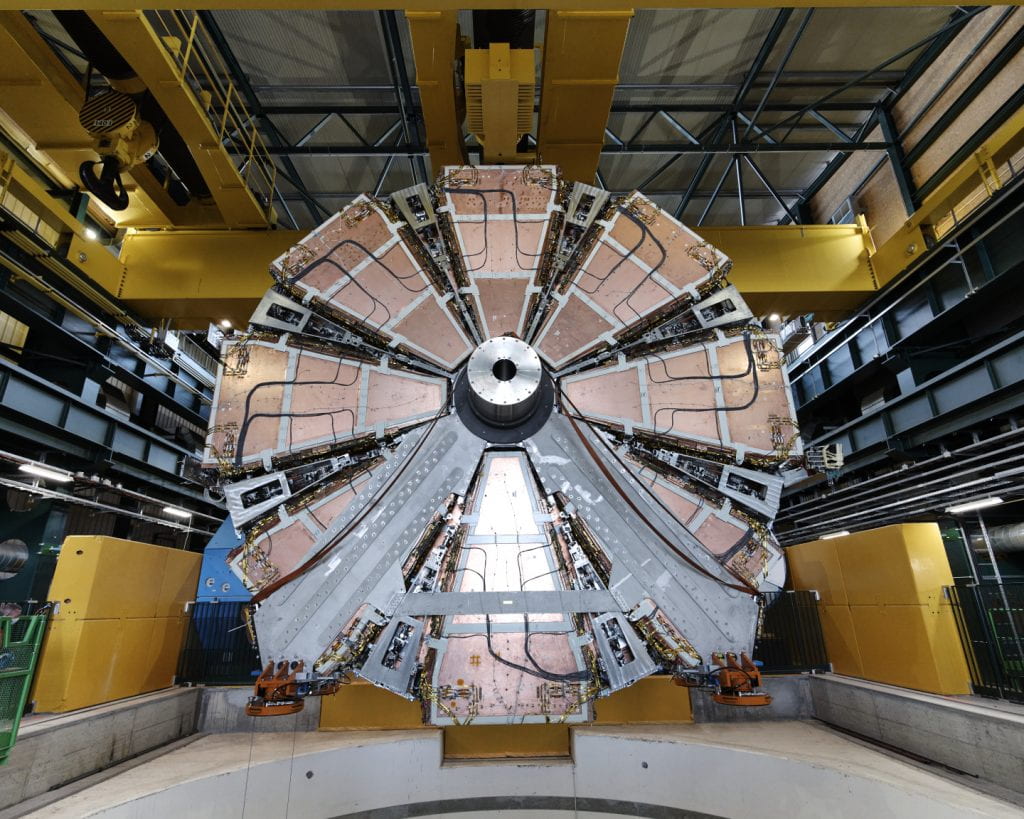
The outreach team and I met to brainstorm some first ideas and came up with the concept of a series of themed workshops, each displaying one of its most noteworthy results on its roof. A gingerbread New Small Wheel sits on a sleigh in the centre of the village, en route to its new home in the experimental cavern underground. At this point the outreach team announced that we’d also need a backdrop to make sure that the scenes were recognisably CERN and ATLAS-related. My colleague asked me “maybe this is crazy, but could you make Building 40 out of gingerbread?”.
Building 40 is one of the most distinctive office buildings at CERN, and houses a large proportion of ATLAS and CMS physicists. The central part of the building has curved walls and a glass domed roof. It’s unique architecture makes it a great choice for a recognisable CERN landmark, but curved walls and domed roof are not the easiest structures to make out of cookies! As luck would have it, making Building 40 out of gingerbread had been at the back of my mind for some time as a potential baking project, so I already had a plan for how to do this technically, and this was a great excuse to finally make it happen.
As you might imagine, building a gingerbread structure on this magnitude requires a fair amount of planning. With a bit of help from photos and satellite images, the first step was to draw up plans to scale, figuring out what components were needed, and how these would all fit together. Once I was happy with the plans I made cardboard mock-ups that would also then form the templates for cutting out the gingerbread dough. The curved gingerbread walls of Building 40 were formed by draping the cookies, still on parchment paper and hot from the oven, over a cylinder of the right diameter. The domed roof is the only non-gingerbread part of the village and is made from rice crispies and melted marshmallows, and then covered in fondant. The walls are glued together with royal icing, which is also used to decorate everything.

We enlisted the help of some other keen ATLAS bakers to help decorate the gingerbread house workshops, and the plots on the roofs of the workshops are printed on edible paper. An event display showing the ATLAS detector all lit up as the LHC beam is steered onto a collimator upstream of the detector and the resulting spray of particles ‘splashes’ through it, graces the roof of the Beams Workshop. The other workshops showcase a handful of our highest priority physics results. My own favorite plot from this year is displayed on the roof of the “DiHiggs workshop” and shows a combination of the results of our searches for Higgs pair-production. SMU played a very prominent role in these analyses and the results set the world’s strongest constraints on the strength of the Higgs boson’s self-interaction.
Building physics-themed gingerbread villages is certainly not something I would have imagined a few years ago that a career as a physicist would involve, but it’s definitely a lot of fun. The only thing that worries me now is how we’re going to top this next year!



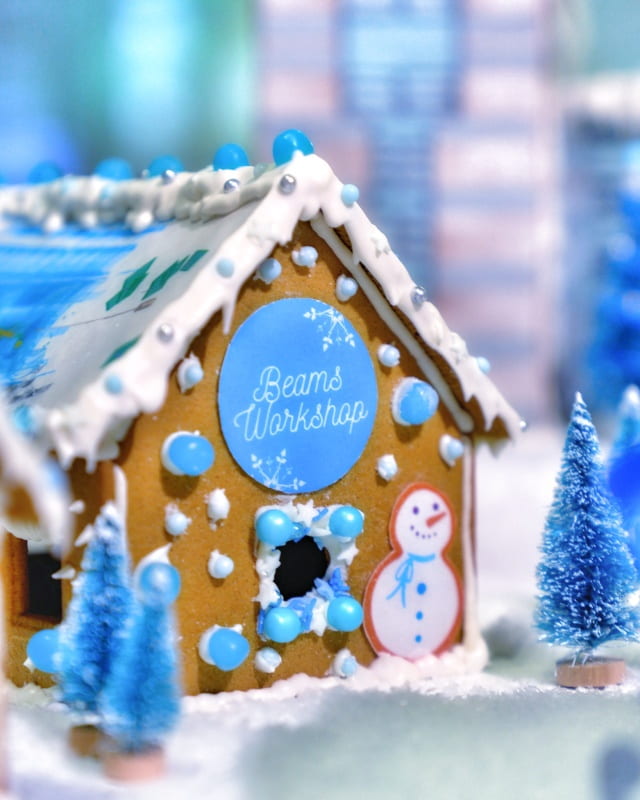





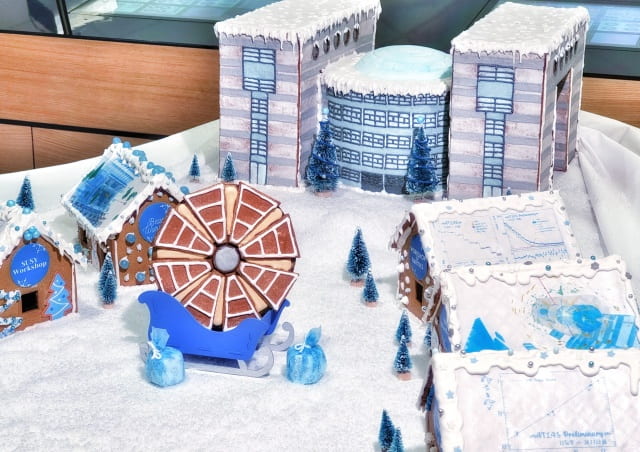


Lab Manager Rick Guarino Has a Shiny New Full-Scale “PASCO Smart Cart”

Rick Guarino, the Lab Manager for the Department of Physics, was pleased to share a development in his life: his first brand new car (ever)! The car is a Subaru BRZ, with 228 horsepower, 184 ft-lbs of torque, a 2.4 L 4-cylinder engine, and a 6-speed manual short throw transmission. In his original message about this, he noted the passing similarity to a PASCO-brand “Smart Cart,” a wireless device for conduction motion-based physics laboratory studies.
Certainly, we all agree this new car looks a lot more fun than a PASCO Smart Cart.

STUDENT NEWS
If you have something to share please feel free to send it along. Stories of students in research, the classroom, internships or fellowships, awards, etc. are very welcome!
Society of Physics Students Chapter at SMU Selected as “Notable” for 2020-2021
 The SMU Society of Physics Student (SPS) chapter has been recognized by the national organization as “Notable” for the period 2020-2021. This distinction is based on their review of the activity report from our SPS leadership. During the period noted, the officers in the SPS were
The SMU Society of Physics Student (SPS) chapter has been recognized by the national organization as “Notable” for the period 2020-2021. This distinction is based on their review of the activity report from our SPS leadership. During the period noted, the officers in the SPS were
- Jared Burleson (President)
- Taylor Wallace (Vice President)
- Katherine Scalise (Secretary)
- Noah Pearson (Treasurer)
- Abigail Hays (Outreach Coordinator)
The SMU SPS is an official SMU student organization. Its faculty advisor is Prof. Randy Scalise, who helps to guide the chapter through recruitment of new members, the election process, selecting activities for each year, and manages the mailing list for the organization. The SPS is a critical organization in our program, as it brings together not just Physics Majors and Minors, and Biophysical Science Majors, but also students with a passion for physics and community who come from other degree programs and a wide array of interests. This helps to shape the engagement of the Physics Department with one of its most important stakeholders: our students.
The Department congratulates the SPS on being noted by the national organization for its efforts, and encourages the organization to continue its activities. The Department provided this year a budget of up to $3,000 to support SPS activities. In the Fall, the SPS held an organizational meeting to share information about department research opportunities and coordinated the “Dark Matter Day” campus-wide rock-hunt activity. SPS leadership has also been instrumental in initiating a process with the Department Chair for update and renewal of the Undergraduate Lab space provided for our majors and minors in FOSC 101. That upgrade is being initiated over the winter break.
ALUMNI NEWS
If you are an alum of the doctoral, masters, majors or minor programs in Physics at SMU, or have worked in our program as a post-doctoral researcher, and wish to share news with the community, please send your story to the Physics Department and we’ll work with you to get it included in a future edition.
THE BACK PAGE
Happy Winter Break!


